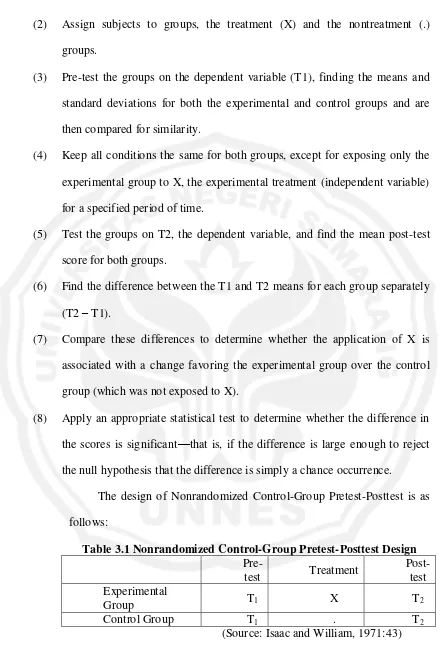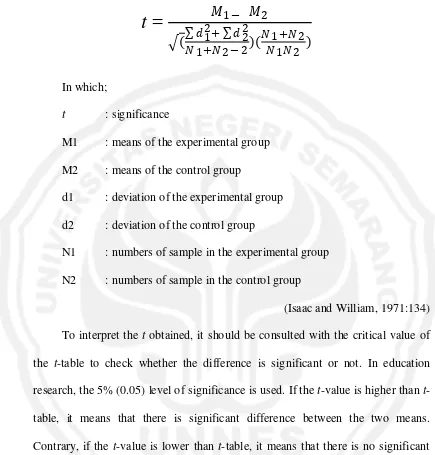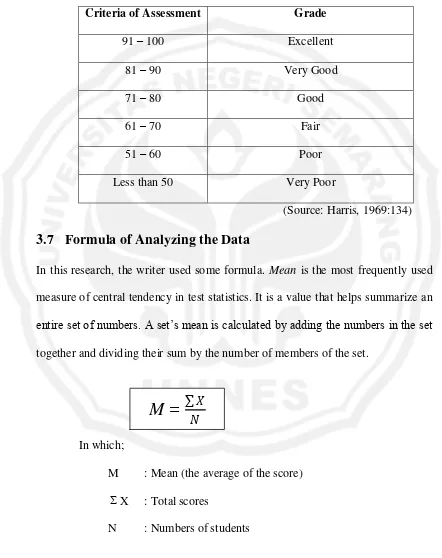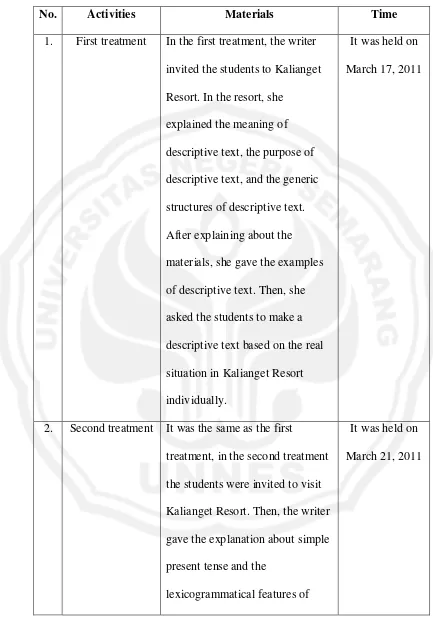Informasi Dokumen
- Penulis:
- Stefindityaningrum Gita Nurani
- Pengajar:
- Intan Permata Hapsari, S.Pd., M.Pd.
- Drs. Hartoyo, M.A., Ph.D.
- Sekolah: Semarang State University
- Mata Pelajaran: English
- Topik: The Effectiveness of Using Study Tour Method to Increase Students’ Skill in Writing Descriptive Text
- Tipe: Final Project
- Tahun: 2011
- Kota: Semarang
Ringkasan Dokumen
I. Introduction
This chapter sets the stage for the research by establishing the context, rationale, and objectives. It begins by highlighting the significance of English language proficiency in Indonesia, emphasizing the importance of writing skills, particularly descriptive writing, within the national curriculum. The chapter then elaborates on the challenges faced by students in writing descriptive texts, such as vocabulary limitations and structural difficulties. This leads to the introduction of the study tour method as a potential solution to enhance students' writing skills, paving the way for the research questions and hypotheses presented later in the chapter.
1.1 Background of the Study
This section establishes the importance of English language skills, especially writing, in the Indonesian educational context, referencing the national curriculum and its emphasis on various text types, including descriptive writing. It highlights the challenges students face in mastering descriptive writing, focusing on difficulties with vocabulary, idea generation, and sentence construction. The section then introduces the study tour method as a pedagogical approach designed to address these challenges by creating a more engaging and immersive learning experience.
1.2 Reasons for Choosing the Topic
This section justifies the research focus on the study tour method for improving descriptive writing skills. It argues that the method can enhance students' engagement and motivation by connecting classroom learning to real-world experiences. The rationale emphasizes the method's potential to improve students' vocabulary, sentence construction, and overall writing fluency by drawing upon direct observation and firsthand experiences. The section also highlights the lack of research on this specific combination of teaching method and writing skill.
1.3 Statement of the Problem
This concise section clearly states the central research question: How effective is the study tour method in improving students' descriptive writing skills? This focused question guides the entire research process, ensuring that all subsequent sections directly contribute to answering it. The simplicity allows for easy comprehension and ensures a clear direction for the investigation.
1.4 Objective of the Study
The objective is explicitly stated as determining the effectiveness of the study tour method in enhancing students’ descriptive writing abilities. This objective provides a clear, measurable goal for the research, making it easy to assess the success of the study by directly analyzing the results against this stated aim. The straightforward nature facilitates a clear and focused approach to data collection and analysis.
1.5 Hypotheses
This section outlines the research hypotheses, proposing that students taught using the study tour method will demonstrate significantly better descriptive writing skills than those taught using alternative methods. The clear articulation of null and alternative hypotheses provides a framework for statistical testing and allows for a definitive conclusion regarding the effectiveness of the study tour method. The hypotheses are designed to be directly testable through the planned experimental design.
1.6 Significance of the Study
This section discusses the potential benefits and implications of the research. It explains how the findings can be valuable to both English language teachers and students, offering a practical, engaging alternative teaching method for improving descriptive writing skills. The significance extends to informing future pedagogical practices and potentially influencing curriculum development. The section also discusses the personal and professional growth of the researcher through conducting this research.
1.7 Limitations of the Study
This section acknowledges the limitations of the study, mainly focusing on the specific sample population and the chosen methodology. This acknowledgment demonstrates transparency and allows readers to understand the context and boundaries of the research findings. By clearly outlining the limitations, the researcher anticipates potential criticisms and strengthens the overall credibility of the work. The limitations prevent the results from being generalized beyond the specified parameters.
1.8 Outline of the Report
This section provides a clear overview of the thesis structure, outlining the content of each chapter. This allows the reader to easily navigate the document and understand the flow of the research process. The clear structure enhances readability and allows for a focused understanding of the different sections and their relationship to the overall research objectives. It also serves as a roadmap for the reader.
II. Review of Related Literature
This chapter provides a comprehensive overview of existing research and theoretical frameworks related to writing skills, descriptive text, and pedagogical approaches. It begins by examining previous studies on writing instruction, focusing on the effectiveness of different methods. The chapter then delves into the theoretical underpinnings of writing skills, exploring the various components that influence writing proficiency, such as vocabulary, grammar, and organization. Furthermore, it examines the characteristics of descriptive texts and explores effective teaching strategies for young learners. Finally, it examines the concept and implementation of study tour methods in education.
2.1 Previous Study
This section reviews relevant prior research on teaching writing, particularly descriptive writing, and the use of various pedagogical approaches. The review contextualizes the current study, highlighting existing knowledge and identifying gaps in the literature. By analyzing previous findings, the section sets the stage for the current research by showing how it builds upon and contributes to the existing body of knowledge. The analysis of prior studies allows the researcher to establish a foundation for their work and identify areas where further research is needed.
2.2 Writing Skill
This section delves into the theoretical underpinnings of writing as a language skill. It examines the various aspects that contribute to effective writing, including vocabulary, grammar, and overall organization. This section provides a conceptual framework for understanding the complexities of writing and establishes a basis for evaluating the effectiveness of the study tour method in improving students' writing abilities. It establishes the criteria for assessing writing quality.
2.3 Concept of Written Language
This section explores the differences between written and spoken language, setting the stage for an understanding of the unique demands of written communication. The discussion highlights the formal aspects of written English and contrasts them with the informal nature of spoken English. This sets the context for understanding the challenges involved in teaching students to write effectively. The section emphasizes the importance of understanding linguistic conventions in written communication.
2.4 Descriptive Text
This section focuses on the specific genre of descriptive text, analyzing its characteristics and structural components. It examines the linguistic features commonly found in descriptive writing and provides a detailed understanding of the genre's purpose and function. This section helps to clarify the specific writing skills that the study aims to improve. It is crucial for establishing clear criteria for assessing students' writing in this particular genre.
2.5 Teaching Writing
This section explores various pedagogical approaches to teaching writing, emphasizing the importance of effective teaching strategies and techniques. It examines the role of the teacher in fostering writing development and creating an engaging learning environment. This sets the context for evaluating the study tour method within the broader landscape of writing instruction. It highlights the importance of considering the learner's needs and providing appropriate support.
2.6 Teaching for Young Learners
This section focuses on age-appropriate methods for teaching writing to young learners. It explores effective strategies for engaging young students in writing activities and adapting teaching methods to their developmental stages. This section provides the basis for assessing the suitability of the study tour method for the target age group. The understanding of child development is key to designing an effective learning experience.
2.7 General Meaning of Study Tour
This section defines and explains the study tour method, outlining its principles and stages of implementation. It examines the potential benefits of this approach in educational settings, establishing its theoretical basis within the context of experiential learning. This section provides the theoretical framework for understanding the chosen methodology and its potential effectiveness in improving students’ writing skills. It demonstrates the rationale for selecting this specific method.
III. Method of Research
This chapter details the research methodology employed in the study. It outlines the research design, participant selection, data collection instruments, and data analysis techniques. A clear description of the methodology ensures the transparency and replicability of the research. The section explains the rationale behind the chosen methods and demonstrates their appropriateness for addressing the research question.
3.1 Research Design
This section details the experimental design used in the study, specifically outlining the pre-test, treatment, and post-test phases. The design ensures a clear comparison between the control and experimental groups, allowing for a valid assessment of the study tour method's effectiveness. The section explains the rationale behind the chosen design, demonstrating its appropriateness for testing the research hypothesis. It clarifies how the data will be collected and analyzed to answer the research question.
3.2 Subject of the Study
This section describes the participant selection process, clarifying the population and sample used in the study. The selection methodology must be explained in detail to ensure the representativeness and generalizability of the findings. The section ensures the study's internal validity by demonstrating the careful selection of participants and the use of appropriate sampling techniques. The description of the participants' characteristics is crucial for interpreting the results.
3.3 Instrument for Collecting the Data
This section details the instruments used to collect data, specifically the tests used for pre-test and post-test assessments. The description must include the criteria for evaluating students' writing samples, ensuring that the assessment is valid and reliable. The section explains how the instruments were developed and validated to ensure accurate and unbiased data collection. The clarity of the assessment criteria is essential for ensuring the objectivity and validity of the study’s results.
3.4 Method of Collecting the Data
This section describes the procedures followed for data collection, highlighting the pre-test, treatment phase (including the study tour), and post-test phases. A step-by-step explanation enhances the transparency and replicability of the research. The section ensures that the data collection process was consistent and reliable, minimizing potential sources of bias. The detail in this section allows readers to understand exactly how the data was gathered and how the experiment was conducted.
3.5 Statistical Design
This section describes the statistical methods used for analyzing the data, including t-tests to compare the means of the control and experimental groups. The selection and application of statistical methods are crucial for demonstrating the rigor and validity of the research. The explanation of statistical procedures ensures that the results can be interpreted correctly and that the conclusions are supported by the data. The section establishes the methodology for drawing inferences from the data.
3.6 Scoring System
This section provides a detailed description of the scoring rubric used to evaluate students' writing samples. This ensures the consistency and objectivity of the evaluation process. The clarity and specificity of the scoring criteria are critical for minimizing bias and ensuring the reliability of the assessment. The detailed scoring rubric is essential for demonstrating the validity and reliability of the data collected.
3.7 Formula of Analyzing the Data
This section specifies the formulas and statistical procedures used for data analysis, ensuring transparency and replicability. The detail in this section allows other researchers to understand the statistical calculations and to replicate the study. The precise description of the statistical analysis is crucial for evaluating the validity and reliability of the conclusions drawn from the data. It enhances the reproducibility and allows for verification of the research process.
IV. Research Findings and Discussions
This chapter presents the results of the data analysis and interprets the findings in relation to the research question and hypotheses. It includes descriptive statistics summarizing the performance of both the control and experimental groups in the pre-test and post-test. Inferential statistics, such as t-tests, are used to determine the statistical significance of the differences between the groups. The chapter also includes a discussion of the findings, examining potential reasons for the observed results and relating them to the existing literature. The chapter will also address the limitations of the research and suggest avenues for future research.
4.1 Data Analysis
This section presents the quantitative data obtained from the pre-test, treatment, and post-test phases, including descriptive statistics (means, standard deviations) and inferential statistics (t-tests) to determine the statistical significance of the differences between groups. A clear presentation of the data allows for a straightforward understanding of the results. The appropriate use of statistical tests ensures the validity of the conclusions drawn. The section's clarity is vital for readers to interpret the findings accurately.
4.2 Normality and Homogeneity
This section assesses the assumptions underlying the statistical tests performed. It ensures the reliability and validity of the inferential statistics used. The verification of these assumptions is crucial for the trustworthiness of the research. The section demonstrates a rigorous approach to data analysis, supporting the reliability and validity of the study's findings. This section addresses critical aspects of statistical validity.
4.3 Significant Difference between the Result of the Pre-Test, Treatments, and Post-Test
This section compares the results of the pre-test, treatment, and post-test to determine the effect of the study tour method. A clear comparison shows the impact of the intervention. The section clearly shows whether the study tour had a significant effect on student performance. The use of statistical tests to support the conclusions enhances the objectivity and validity of the findings.
4.4 Difference between the Two Means
This section focuses on the comparison of means between the experimental and control groups using appropriate statistical tests. It provides a clear understanding of the magnitude of the difference in performance between the groups. The section is crucial for establishing the impact of the study tour method. The use of statistical tests adds rigor to the comparison and ensures the reliability of the findings.
4.5 Analyzing the t-test
This section interprets the results of the t-test to determine whether the observed differences between the groups are statistically significant. The interpretation must be clear and well-supported by the data. The section explains the implications of the t-test results for the research hypotheses. A clear interpretation is essential for establishing whether the study tour method is effective.
4.6 Discussion of the Research Findings
This section interprets the findings in the context of existing literature and theoretical frameworks. It provides a comprehensive analysis of the results and relates them to the research question and hypotheses. The discussion explains any unexpected or surprising findings and explores the implications of the research for educational practice. The thoughtful discussion strengthens the contribution of the research to the field.
4.7 The Advantages of Using Study Tour Method in Teaching Writing Descriptive Text
This section highlights the benefits and drawbacks of the study tour method. It provides a balanced assessment of the method’s effectiveness and its limitations. The discussion of both advantages and disadvantages provides a well-rounded perspective on the use of the study tour method. The section allows for a comprehensive evaluation of the method’s practicality and efficacy.
V. Conclusions and Suggestions
This chapter summarizes the key findings of the study and offers concluding remarks based on the results obtained. It reiterates the answers to the research questions and the implications of the findings for educational practice. The chapter also includes suggestions for future research, identifying potential avenues for further investigation and expanding on the current study's limitations. The concluding remarks summarize the main contributions of the research.
5.1 Conclusions
This section summarizes the main findings of the study and answers the research question. The conclusions are concisely stated and supported by the data presented earlier. The conclusions directly address the research objectives and hypotheses, providing a clear and unambiguous summary of the study’s outcomes. This section offers a brief and impactful summary of the research findings.
5.2 Suggestions
This section provides recommendations for future research and practical applications of the findings. It identifies potential areas for further investigation, suggesting modifications or extensions to the current study. The suggestions contribute to the advancement of knowledge in the field and highlight the practical implications of the research. The suggestions demonstrate a forward-looking approach, aiming to enhance the application of the research findings.









